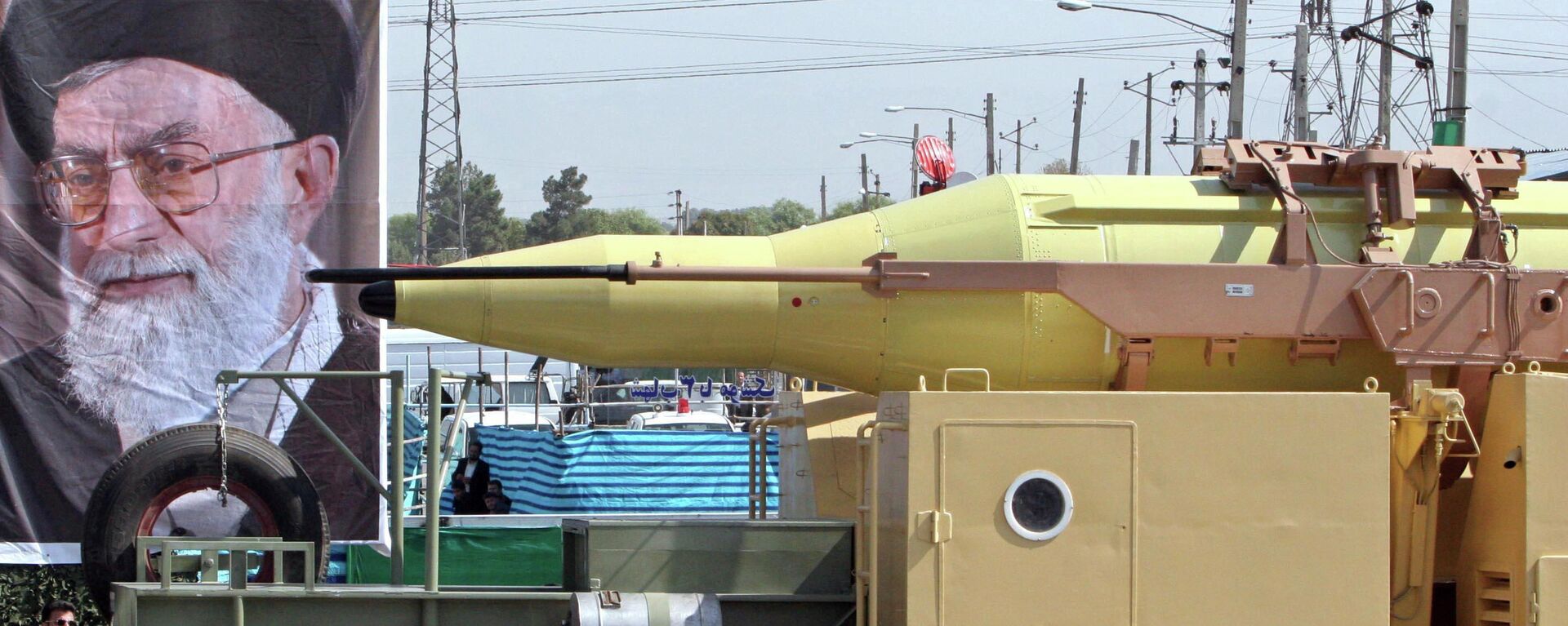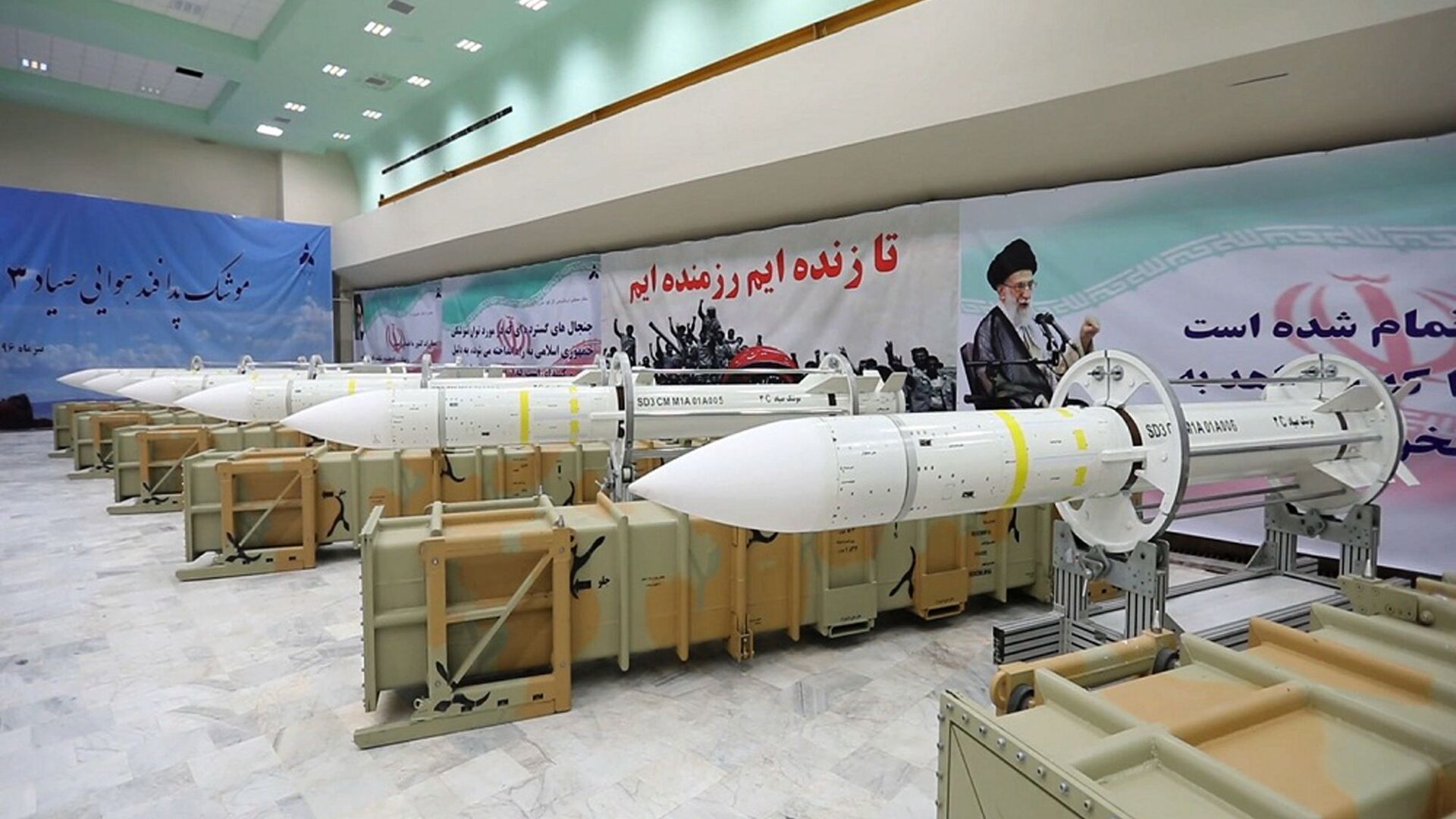https://sputnikglobe.com/20221128/iran-has-missiles-that-can-slip-through-enemy-missile-shields-top-commander-says-1104800286.html
Iran Has Missiles That Can Slip Through Enemy Missile Shields, Top Commander Says
Iran Has Missiles That Can Slip Through Enemy Missile Shields, Top Commander Says
Sputnik International
The Pentagon estimates that Iran has more than 3,000 ballistic and cruise missiles in its arsenal. Many have a long-enough range to strike Israel – Iran’s... 28.11.2022, Sputnik International
2022-11-28T19:04+0000
2022-11-28T19:04+0000
2022-11-28T19:04+0000
military
iran
missile
hypersonic
deterrent
https://cdn1.img.sputnikglobe.com/img/105579/45/1055794595_0:187:2000:1312_1920x0_80_0_0_118dc6bcf8f4a1feb0a6efced7614b9d.jpg
Iran has missiles in its inventory that can penetrate enemy missile defense forces and leave them in a state of ruin for “decades,” Islamic Revolutionary Guard Guards Aerospace Force Commander Amir Ali Hajizadeh has indicated.Hajizadeh first provided information on the new Iranian weapons system on November 10, calling it a “great generational leap in the missile field” and emphasizing that Iran’s adversaries will be unlikely to find the means to counteract it for decades. The commander remained tight-lipped regarding details on the new missile’s range and other characteristics, but did say that it could maneuver in flight and fly at trajectories which making it extremely difficult to intercept.A Pentagon spokesman expressed “skepticism” over Iranian media reports regarding its new hypersonic missile system, but US military officials have been proven wrong before. In 2020, several months after US Space Force chief of operations Jay Raymond described an IRGC surveillance satellite as little more than a useless “tumbling webcam in space,” Iran published high-resolution snaps sent back by the satellite of Al-Udeid Air Base – the largest US base in the Middle East.Israeli officials appear to have taken Iran’s hypersonic developments more seriously, with sources telling media earlier this month that the Israeli military anticipated the news, and has accelerated work on a new missile interceptor system, known as the Arrow-4.Iran and Israel remain in a permanent state of being a hair’s breadth away from conflict, cutting off relations with one another after the Iranian Revolution of 1979. Since then, the countries have waged covert intelligence and cyber wars against one another, and threatened to attack another militarily.Israel created a special $1.5 billion budget last year specifically to make preparations for an attack on Iran’s nuclear facilities amid allegations by Tel Aviv that Tehran seeks to build a nuclear bomb. Iran has denied having nuclear ambitions, and warned that it would turn Israeli cities into rubble if attacked.Israeli and US air power plan to hold large-scale bomber and fighter jet drills this week simulating an attack on Iran’s nuclear program. This is at least the second time that the US plans to join such exercises since May.
https://sputnikglobe.com/20221110/iran-develops-first-national-hypersonic-ballistic-missile-irgs-1103965481.html
iran
Sputnik International
feedback@sputniknews.com
+74956456601
MIA „Rossiya Segodnya“
2022
News
en_EN
Sputnik International
feedback@sputniknews.com
+74956456601
MIA „Rossiya Segodnya“
Sputnik International
feedback@sputniknews.com
+74956456601
MIA „Rossiya Segodnya“
iran missile, iran hypersonic missile, hypersonic missile, iran, missile defense
iran missile, iran hypersonic missile, hypersonic missile, iran, missile defense
Iran Has Missiles That Can Slip Through Enemy Missile Shields, Top Commander Says
The Pentagon estimates that Iran has more than 3,000 ballistic and cruise missiles in its arsenal. Many have a long-enough range to strike Israel – Iran’s regional arch-nemesis, in the event that Tel Aviv launches an attack on Tehran’s nuclear facilities.
Iran has missiles in its inventory that can penetrate enemy missile defense forces and leave them in a state of ruin for “decades,” Islamic Revolutionary Guard Guards Aerospace Force Commander Amir Ali Hajizadeh has indicated.
“The IRGC’s Aerospace Force…has managed to achieve a remarkably high level of deterrence in the area of missile, drone, air defense, aircraft, radar and space industries. Its latest achievement is capable of disabling missile defense shields of the enemies of Iran, including the United States, the Zionist regime and their proxy governments, for many decades,” the commander said, speaking at an exhibition in Tehran on Monday, and referring to Iran’s recently unveiled hypersonic missile.
Hajizadeh first provided information on the new Iranian weapons system on November 10, calling it a “great generational leap in the missile field” and emphasizing that Iran’s adversaries will be unlikely to find the means to counteract it for decades. The commander remained tight-lipped regarding details on the new missile’s range and other characteristics, but did say that it could maneuver in flight and fly at trajectories which making it extremely difficult to intercept.
A Pentagon spokesman expressed
“skepticism” over Iranian media reports regarding its new hypersonic missile system, but US military officials have been proven wrong before. In 2020, several months after US Space Force chief of operations Jay Raymond
described an IRGC surveillance satellite as little more than a useless “tumbling webcam in space,” Iran published high-resolution
snaps sent back by the satellite of Al-Udeid Air Base – the largest US base in the Middle East.

10 November 2022, 07:20 GMT
Israeli officials appear to have taken Iran’s hypersonic developments more seriously, with sources
telling media earlier this month that the Israeli military anticipated the news, and has accelerated work on a new missile interceptor system, known as the Arrow-4.
Iran and Israel remain in a permanent state of being a hair’s breadth away from conflict, cutting off relations with one another after the Iranian Revolution of 1979. Since then, the countries have waged
covert intelligence and
cyber wars against one another, and threatened to attack another militarily.
Israel created a special $1.5 billion budget last year specifically to make preparations for an attack on Iran’s nuclear facilities amid allegations by Tel Aviv that Tehran seeks to build a nuclear bomb. Iran has denied having nuclear ambitions, and warned that it would turn Israeli cities into rubble if attacked.
Israeli and US air power
plan to hold large-scale bomber and fighter jet drills this week simulating an attack on Iran’s nuclear program. This is at least the second time that the US plans to join such exercises since May.



